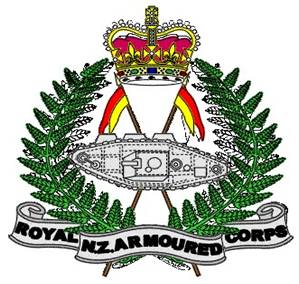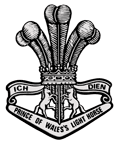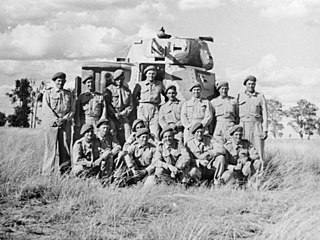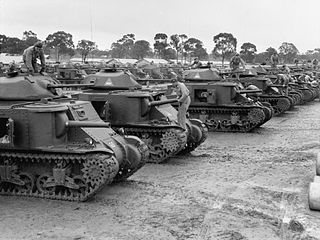
The Royal Australian Armoured Corps (RAAC) is an administrative corps of the Australian Army. It provides the Australian Defence Force's Armour capability, which performs the function of mounted combat. Armour combines firepower, mobility, protection and networked situational awareness to generate shock action and overmatch in close combat. Armour is an essential element of the combined arms approach that is employed by the Australian Army.

1st Armoured Regiment is an armoured regiment of the Australian Army and is the senior regiment of the Royal Australian Armoured Corps. Formed as a tank unit in the new Australian Regular Army on 7 July 1949, the regiment subsequently saw service during the Vietnam War operating Centurion tanks. Currently the unit is based in Edinburgh, South Australia as part of the 9th Brigade. As part of the Plan Beersheba reorganisation, the unit has become one of three Armoured Cavalry Regiments (ACRs) assigned to the Army's multirole combat brigades in Brisbane, Darwin and Townsville. Each ACR is equipped with M1A1 tanks and ASLAV light armoured vehicles.

The 2nd Cavalry Regiment is an armoured cavalry regiment of the Australian Army. Formed in 1965 as the "1st Cavalry Regiment", it is the second most senior regiment in the Royal Australian Armoured Corps. In 1970, the regiment was redesignated as the "2nd Cavalry Regiment", to differentiate it from the 1st Armoured Regiment. The regiment was based at Holsworthy until 1992 when it was allocated to the 1st Brigade based in Darwin in the Northern Territory. In late 2014 the regiment was transferred to the 3rd Brigade, and is now based in Townsville in Queensland. The unit is equipped with M1A1 tanks, ASLAV light armoured vehicles and M113AS4 APCs.

The Australian Light Armoured Vehicle (ASLAV) is an eight-wheeled amphibious armoured reconnaissance vehicle of the LAV II family used by the Australian Army. It was built by General Dynamics Land Systems Canada, and developed from the U.S. Marine Corps' LAV-25 and Canadian Army's Bison armoured fighting vehicles.

The Royal New Zealand Armoured Corps (RNZAC) is the overall umbrella grouping of Regular Force and Territorial Force units equipped with armoured vehicles in the New Zealand Army. The corps was formed in 1942 as the New Zealand Armoured Corps, before being given the Royal prefix in 1947. The RNZAC is second in seniority of corps within the New Zealand Army.

The 4th/19th Prince of Wales's Light Horse is a cavalry regiment of the Australian Army. The regiment in its current composition was formed in 1948 when the Citizens Military Force (CMF) was re-raised after the completion of the demobilisation process following the end of the Second World War and it was formed through the amalgamation of three previously existing regiments. Through these predecessor units, 4/19 PWLH can trace its lineage back to the 19th century and today it is the custodian of the battle honours earned by these units. The regiment had a Regular squadron, 1 Troop 4th/19th Prince of Wales Light Horse Regiment, which was posted to South Vietnam in 1965 where it was attached to 1 RAR operating out of Bien Hoa Province. It returned to Australia on 28 May 1966 and became part of the Regular cavalry units that continue to exist in the Australian Army today. These units subsequently served during the Vietnam War and many of their personnel continued to wear regimental accoutrements while in South Vietnam.

6th Battalion, Royal Australian Regiment is a mechanised infantry battalion of the Australian Army. It was originally raised in Brisbane, Queensland, on 6 June 1965 and has since then served in a number of overseas deployments and conflicts including South Vietnam, East Timor, Iraq and Afghanistan. During the Vietnam War, the battalion earned a US Presidential Unit Citation from the United States when members from 'D' Company participated in the Battle of Long Tan on 18–19 August 1966. The battalion is currently based at Gallipoli Barracks in Brisbane and forms part of the 7th Brigade.

The 2nd Armoured Division was an armoured formation of the Australian Army during World War II. Originally raised in 1921 as the 2nd Cavalry Division, based in Victoria and South Australia, the formation had been converted into a motor division in early 1942, before adopting the armoured designation later in the year. A Militia formation, the division undertook garrison duties in Australia and did not see combat before being disbanded in mid-1943.

Armoured units made a relatively small, but important, contribution to Australia’s war effort during World War II. While Australia formed three armoured divisions and two independent armoured brigades during the war, Australian armoured units only saw action as independent regiments and companies supporting larger infantry formations. Early actions were fought in the Middle East by the divisional carrier regiments that supported the 6th, 7th and 9th Divisions, fighting in Libya, Egypt and Syria in 1941–42, before the Australian divisions returned to Australia in 1942–43. During the early fighting in the Pacific, there was a limited role for armoured formations, although one armoured regiment – the 2/6th – took part in the fighting around Buna–Gona in late 1942. Later in the war, though, during the Huon Peninsula, Bougainville and Borneo campaigns of 1943–45, several armoured units were used by Australian forces in the infantry support role.

The 12th/16th Hunter River Lancers is an Australian Army Reserve cavalry regiment. It was formed on 1 May 1948, although it draws its lineage from units that were originally formed in the 1880s. It is currently a Heavy Cavalry unit equipped with Bushmaster Protected Mobility Vehicles. The regiment forms part of the 11th Brigade, attached to the 2nd Division and draws its members from regional centres in northern New South Wales, hence the reference to the Hunter River. Since 2000 the regiment has provided individuals as reinforcements to round-out Regular Army units deploying overseas on peacekeeping operations and in the conflicts in Iraq and Afghanistan.
The 2/9th Cavalry (Commando) Regiment was one of three commando regiments raised by the Australian Army for service during World War II. It was originally raised in 1940 as an armoured cavalry unit as part of the 8th Division, before being transferred to the 9th Division. Between 1941 and 1942 the regiment saw action in the Middle East before being returned to Australia in early 1943. At this time the regiment was re-organised as the administrative headquarters for the 2/4th, 2/11th and 2/12th Commando Squadrons and it was converted into a commando regiment. Later in 1945 the unit saw action during the landings on Tarakan on Borneo before being disbanded upon the cessation of hostilities.

The 1st Armoured Personnel Carrier Squadron was an armoured unit of the Australian Army raised for service during the Vietnam War. Raised in 1965, the unit was deployed to South Vietnam in May 1966 to join the 1st Australian Task Force. After that 1 APC Sqn was involved in numerous operations in support of the 5th and 6th Battalions, the Royal Australian Regiment, with the most notable action coming on 18 August 1966 when the squadron was involved in the Battle of Long Tan. In January 1967, 1 APC Sqn was redesignated as 'A' Squadron, 3rd Cavalry Regiment.

Operation Toan Thang I was a U.S. Army, Army of the Republic of Vietnam (ARVN), 1st Australian Task Force and Royal Thai Volunteer Regiment operation conducted between 8 April and 31 May 1968 in the Vietnam War. The operation was part of a reaction to the Tet Offensive designed to put pressure on Vietcong (VC) and People's Army of Vietnam (PAVN) forces in III Corps.

The 2nd Armoured Brigade was a formation of the Australian Army during World War II. The brigade was formed in July 1941, at Puckapunyal, Victoria, from Second Australian Imperial Force volunteers. It was assigned to the 1st Armoured Division in July 1941, with the intention of deploying it to the Middle East. However, it was reassigned to home defence following Japan's entry into the war, and was then transferred to the 3rd Armoured Division in October 1942. The brigade remained in Australia, undertaking defensive duties in Victoria and Queensland before being disbanded in January 1944. While it did not see any active service as a formation, some of its constituent units eventually took part in the campaigns on Tarakan, Labuan, Bougainville and around Aitape–Wewak in 1944–1945 after transferring to other brigades.

The 3rd/9th Light Horse is a Reserve light cavalry regiment of the Australian Army based in Smithfield, South Australia. It is constituted of a single squadron. It is part of the Royal Australian Armoured Corps (RAAC), the regiment is attached to the 9th Brigade, and currently operates Hawkei Protected Mobility Vehicle - Light (PMV-L). On 26 October 2022, 9th Brigade transitioned as a Direct Command to Forces Command (FORCOMD) as part of an Army wide transformation. 3rd/9th Light Horse, 1st Armoured Regiment officially commenced on 1 November 2022.

The Australian Army has used tanks from after the First World War, through the interwar period, the Second World War, the Cold War and to the present day. Throughout this period the Army has primarily been a light infantry force, with its tanks mainly being used in the direct support role. The Australian Army's tanks have seen combat during the Second World War and the Vietnam War, where they proved successful despite some of the designs employed being considered obsolete. The first Australian tanks were a small number of British medium and light tanks which were operated mainly for training purposes during the 1920s and 1930s.
The 8th/13th Victorian Mounted Rifles was an armoured regiment of the Australian Army Reserve. Formed in 1948, the regiment initially operated M3 Grant medium tanks, but was later re-equipped with Centurion tanks in the late 1950s. Operating out of several depots across northern Victoria and southern New South Wales, throughout the 1950s, 60s and 70s the regiment undertook both an armoured and reconnaissance role operating both tanks and armoured cars before being re-equipped with M113A1 armored personnel carriers in the early 1970s. In 1976, the regiment was reduced to a squadron sized element. It was eventually merged with the 4th/19th Prince of Wales's Light Horse in 1992.

The order of battle of Australian forces during the Vietnam War consisted of a small group of military advisors from 1962, but grew to include an infantry battalion based in Bien Hoa in 1965. This force was then replaced by a two- and later three-battalion task force with supporting arms based at Nui Dat which operated primarily in Phuoc Tuy Province between 1966–71, with logistic elements at Vung Tau. Airforce units committed initially consisted of transport aircraft, but were followed by helicopters and later bombers, while naval forces included destroyers and transport vessels. With the size of Australian forces in Vietnam reaching a peak in early 1968, a drawdown commenced in late 1970, with the bulk withdrawn by early 1972. The last elements returned to Australia in 1973. In total, around 50,000 Australians served during the Vietnam War, including 42,437 members of the Australian Army, 3,310 from the Royal Australian Navy (RAN), and 4,443 from the Royal Australian Air Force (RAAF), with casualties including 519 killed and 2,348 wounded.

The 14th Armoured Regiment was a unit of the Australian Army, which served during World War II. The regiment was formed in May 1942 as part of the 6th Australian Armoured Brigade. It was originally a Militia unit which originated from the 17th Light Horse Regiment. It was disbanded in early 1943 without seeing combat.

The Australian Army has operated M113 armoured personnel carriers since 1964. An initial pair of M113s was purchased for trials purposes in 1962. Either 817 or 840 were acquired by 1979, comprising nine different variants. A long-running modernisation program that commenced in the 1990s resulted in 431 M113s being upgraded between 2007 and 2012. All of the upgraded M113s remain in service as of 2020.




















